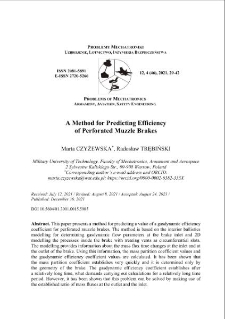Our Digital Library contains 1 868 digital objects
Object
Title: A Method for Predicting Efficiency of Perforated Muzzle Brakes
Alternative title:
Metoda przewidywania skuteczności perforowanych hamulców wylotowych
Contributor:
Abstract:
This paper presents a method for predicting a value of a gasdynamic efficiency coefficient for perforated muzzle brakes. The method is based on the interior ballistics modelling for determining gasdynamic flow parameters at the brake inlet and 2D modelling the processes inside the brake with treating vents as circumferential slots. The modelling provides information about the mass flux time changes at the inlet and at the outlet of the brake. Using this information, the mass partition coefficient values and the gasdynamic efficiency coefficient values are calculated. It has been shown that the mass partition coefficient establishes very quickly and it is determined only by the geometry of the brake. The gasdynamic efficiency coefficient establishes after a relatively long time, what demands carrying out calculations for a relatively long time period. However, it has been shown that this problem can be solved by making use of the established ratio of mass fluxes at the outlet and the inlet. So, flow parameters’ values at the inlet are sufficient for determining the gasdynamic efficiency coefficient to the moment of attaining the final value. It has been shown that this value depends on the ballistics and on the vents inclination angle.
Place of publishing:
Warszawa
Publisher:
Date created:
Date submitted:
Date accepted:
Date issued:
Extent:
Identifier:
oai:ribes-88.man.poznan.pl:2622
Call number:
Electronic ISSN:
Print ISSN:
Language:
License:
Rights holder:
Starting page:
Ending page:
Volume:
Keywords:
ballistics, muzzle brake, gasdynamic efficiency coefficient
Object collections:
Last modified:
Oct 3, 2025
In our library since:
Oct 3, 2025
Number of object content hits:
0
All available object's versions:
https://ribes-88.man.poznan.pl/publication/2946
Show description in RDF format:
Show description in OAI-PMH format:
| Edition name | Date |
|---|---|
| A Method for Predicting Efficiency of Perforated Muzzle Brakes | Oct 3, 2025 |
Objects Similar
Marta CZYżEWSKA Radosław TRĘBIŃSKI
Marta CZYżEWSKA Radosław TRĘBIŃSKI
Marta CZYżEWSKA Jakub MICHALSKI, Zbigniew SURMA

